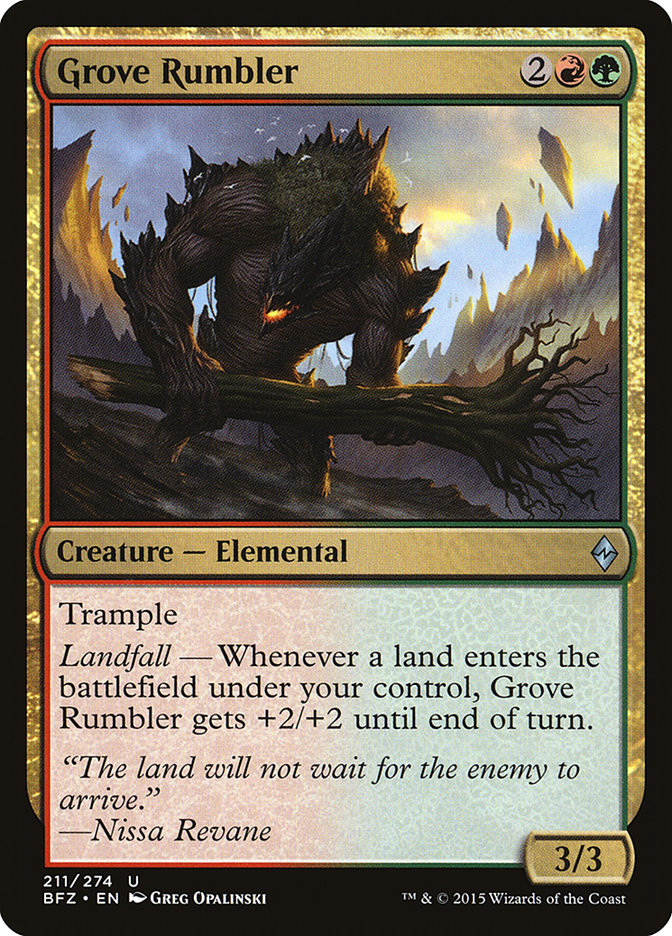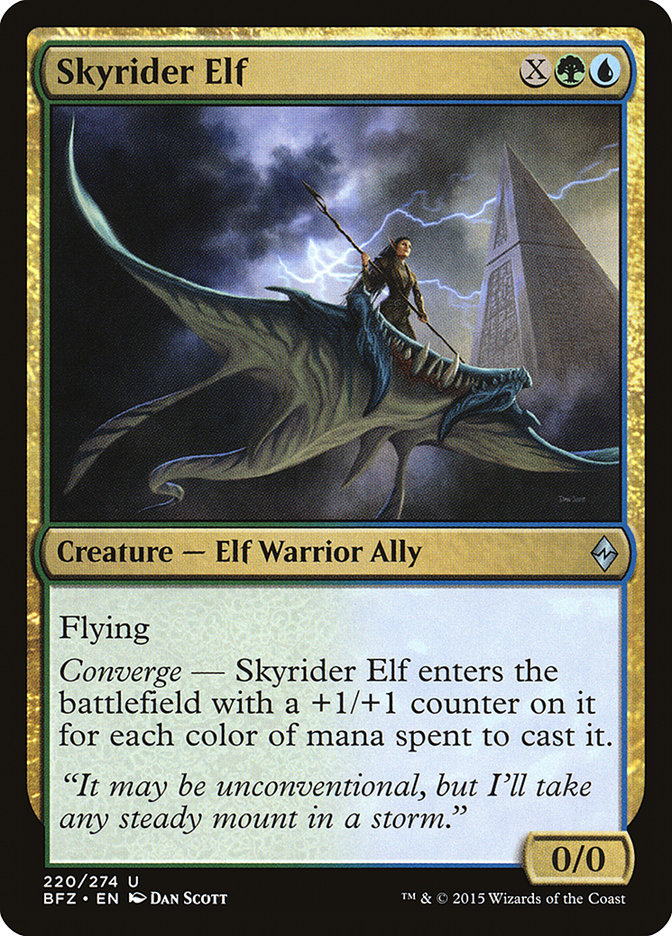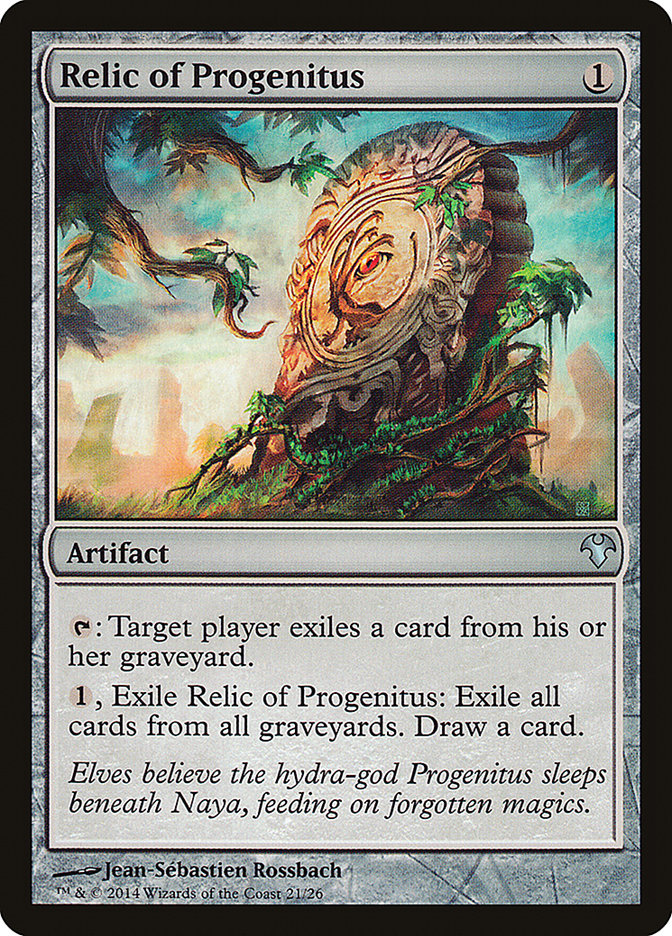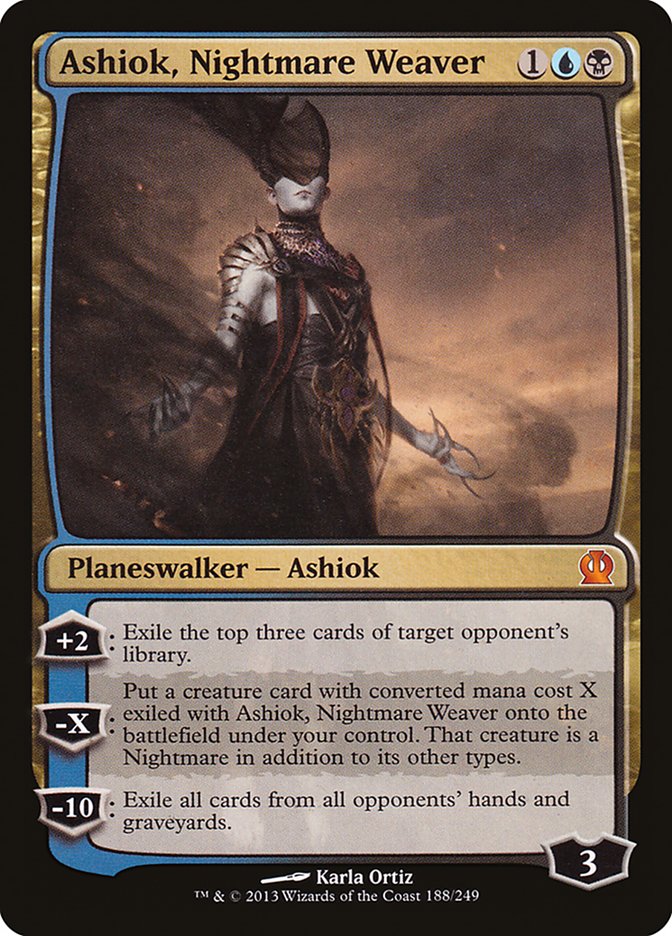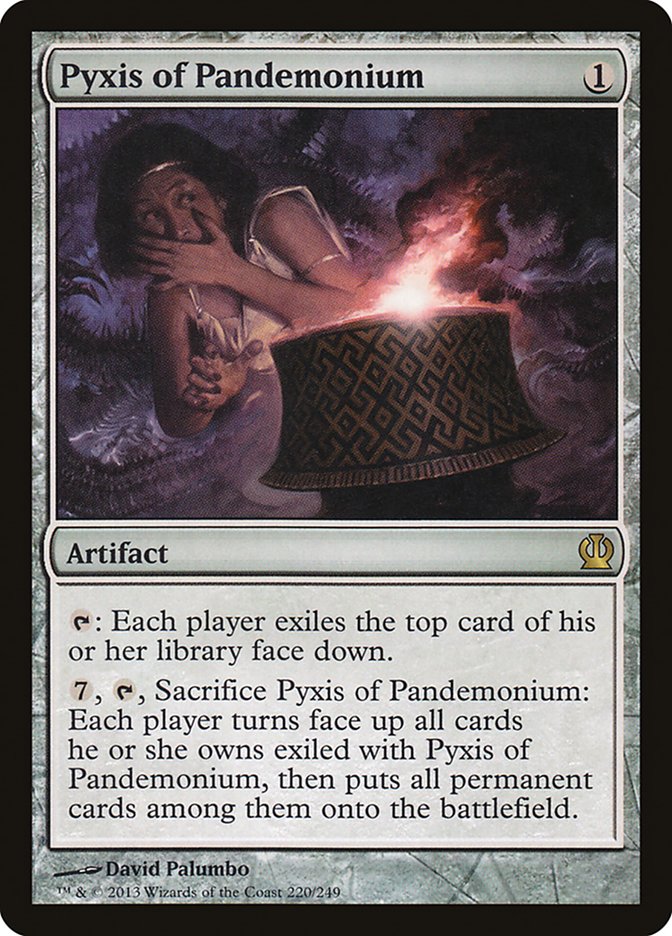In my criticism of Battle for Zendikar, I failed to notice that the sets I was comparing it to to make a point about surprising directions for set
design (that it doesn’t seem to play well enough with Magic at large) are sets that I personally love, even if I’ve gotten the impression that Wizards of
the Coast considers them failures.
Yes, reading over the cards, things like devoid, ingest, and being an Ally feel meaningless and hard to parse without playing the set, but in Limited, they
really do matter a lot in ways that make them get noticed, which makes them easy to remember for me. Having played with the set, the picture has become
much clearer, and all the little oddities have started to make a lot more sense.
I’ve only played three Sealed events and five drafts, but I’ve had a ton of fun with it, and now that I understand what’s going on, it has all makings of a
great format. Synergy is extremely important in this set, and all the good decks are definitely “doing something,” but the things they’re doing have enough
fringe support in other colors that unconventional versions of the decks will sometimes pop up. Let’s go over what the color pairs are up to so I can
explain what I mean.
U/W
U/W has the most awaken, and the U/W uncommon, Roil Spout, is an awaken card. It’s hard for that to be a thing because it’s not really a linear mechanic,
and in many ways, it seems like you’d want to avoid having too much awaken because each one can end up “spending” a land, and you only have so many of
those, but when it’s combined with cards like Fortified Rampart and Tightening Coils that are great cards for a control deck, but undesirable elsewhere,
the awaken cards offer a powerful lategame for the deck to build too, so that your control deck doesn’t necessarily need you to open bombs to reliably be
able to win long games.
On the other hand, U/W also supports a tempo flier deck. These colors have tons of fliers that aren’t really “priced to move” in other strategies,
particularly because most of them don’t play to other synergies. For example, Kitesail Scout isn’t an Ally, so it’s more likely that the dedicated U/W
Skies deck can get them very late if it wants them because the Ally drafter won’t snipe them. All of the fliers at common aren’t Allies. This deck also
makes good use of those same defensive cards, which means that you can take them early if you’re U/W and still have flexibility about whether your deck
ends up being aggressive or controlling. If other people are sniping your awaken cards because they are just generically good, you can just pick up late
fliers and Inspired Charges and plan to win races.
U/B
At its core, U/B is about processing. While every color except white has colorless cards and Eldrazi, only blue and black have creatures with ingest at
common, and they each have three. Red and green have a few ways to exile cards and a couple Processors, but if you want to consistently be able to use a
Processor, you’re going to have to be at least black or blue, and if you’re both, you can really get those engines working. Like U/W, it can easily go in a
very aggressive or very controlling direction. You can curve out with cheap ingest creatures and take advantage of the enters the battlefield trigger on
Dominator Drone, push the tempo on Murk Strider, and finish people off with Swarm Surge; or you can plan to sit back and get hits in with Benthic
Infiltrator to enable gradual card advantage from Mind Raker and Oracle of Dust before finishing people off with awaken cards and Eldrazi monsters.
B/R
The way the Eldrazi are split is pretty awesome. B/R cares about very different things than U/B. This is the “colorless matters” pair, and it’s not likely
to prioritize Processors or worry that much about exiling cards. This is highlighted by comparing Ulamog’s Nullfiier to Forerunner of Slaughter (as a side
note, whenever a set has one uncommon gold card of each color pair, there’s a good chance those cards offer strong clues about what the color pairs are
trying to do). It’s worth noting that, really, red is the “colorless matters” color, and black can just play along because the red and black gold cards
care and Swarm Surge cares, but Vile Aggregate, Molten Nursery, and Nettle Drone are really driving the show here.
B/R decks will almost always want to prioritize colorless creatures, though it is possible to end up with an Ally creature base instead, but each color’s
Allies tend to play better with another colors strategies, and while there’s certainly a range in how aggressive these decks can be, that’s mostly going to
be a function of how much removal you end up with. Red has three great common removal spells, so you might have a lot, and as a result, I think the split
between aggro and control decks in this color pair is much more fluid, which is often the case with B/R.
G/R
The uncommon points to this pair being “the landfall deck.” Blue, white, and black each have one common, one uncommon, and one rare with landfall, but red
has three commons and three uncommons, and green has two commons and four uncommons. They each have a rare and a mythic as well. The landfall deck is
pushed heavily toward being aggressive, because all the creatures are better on your turn. Because you want a high land count and cards like Swell of
Growth and Natural Connection that put extra lands in play, you’re also pushed to go up the curve and play some big cards, G/R will almost never be a
reactive deck, but there can be a pretty wide range in whether this deck is trying to win early or win big.
G/R also has a lot of other subthemes it can play to. Both colors have quite a few Allies that work well together, and green does offer enough support for
red’s colorless matters cards that you can end up going that way, especially maximizing the interaction between Vile Aggregate and green making Eldrazi
Scions.
G/W
This can also go in several directions. Green ramp can support white defense and awaken cards or big Eldrazi, green Eldrazi Scions can support Inspired
Charge, Cliffside Lookout, and Tajuru Beastmaster based “go wide” decks, and the deck can push the Ally theme. Rally as a mechanic is primarily in white
and red, but having a green base allows you to push the Ally theme by splashing Allies from other colors.
B/W
The central theme that’s pushed here is “gaining life matters,” which has strong Ally roots, but exists on Allies that are likely to be lower priorities
for other Ally decks. This can lead to very traditional Orzhov feeling “nickel and dime” style decks, but this color pair can also share the roots of the
U/W Skies decks that push evasion or the awaken control style that can exist in any combination of white, blue, and black.
U/R
As with B/R, red’s colorless matters theme ends up trumping blue’s Processor theme because red doesn’t support the Processor engine. Again, we see
colorless matters in this pair’s uncommon, Herald of Kozilek. As with the other decks, this deck can potentially borrow blue’s colored fliers or red’s
aggressive landfall creatures to support an aggressive plan that makes use of red’s good removal and blue’s abundant tempo cards, or the deck can go more
controlling, as red’s high toughness colorless creatures can pair with red removal and blue card draw.
G/B
The design of this set clearly points to this color pair being about sacrificing Eldrazi Scions to cards like Bone Splinters and Altar’s Reap, or going
wide with Eldrazi Scions and Swarm Surge, but I haven’t seen a version of this that I really like. Eldrazi Scions are good enough that I’m not really
trying to sacrifice them. I’m happy to sacrifice a Blisterpod or an Eyeless Watcher, but I don’t really want to play a 1/1 for one in an eighteen-land
format where no one’s attacking with one toughness creatures on the ground; it’s just way too much work to turn Blisterpod into a card in this format.
I can imagine maybe trying to pair Eyeless Watcher with ways to sacrifice it and then ways to get it back, like Dutiful Return and Mortuary Mire, but at
that point I feel like I’m working really hard for a couple Eldrazi Scions. I could try to use those Scions to cast big Eldrazi, but there are so many good
ways to punish that–Eldrazi monsters are just very easy to kill or bounce in this format, so I’m pretty hesitant to want to sacrifice 1/1s to cast them. I
could easily be missing something, but I think this color pair came up short enough that it was a bit of a design failure, like U/W in Dragons of Tarkir.
R/W
It’s pretty hard to imagine drafting this as anything other than a rally deck, which, like landfall, means your creatures are better on your turn, which
strongly pushes attacking, which uses your creatures on your turn, as opposed to blocking, which uses your creatures on your opponent’s turn. It’s worth
noting that combat tricks are worse than they’d normally be in a deck that wants to attack every turn because you’re going to be incentivized to cast your
creatures before combat, so you often won’t have mana to cast tricks. Of course this also means that cheap tricks, like Lithomancer’s Focus, are at a
premium.
The fact that red’s other major theme is colorless matters, which white can’t support at all means that this pair is lacking a bit of flexibility, so it
can be dangerous to try to draft if someone else is also trying to draft it, but the payoffs on having a lot of rally are impressive beyond my
expectations. I’m really not sure how or why you’d draft this color pair as a control deck outside of getting rares that push you that way, which is pretty
common for R/W across Limited formats.
G/U
The uncommon points to this color pair being the converge deck. There are only twelve converge cards in the set, and half of them are rare. Blue has two
commons, green has one, and the uncommons are blue, G/U, and white. The enablers for converge are all green, so green will be the primary color, blue is
expected to be the secondary color, and then other colors can be splashed for support cards and to power converge. Modern Masters did something
similar with blue/green. Converge plays well with Allies, as both converge creatures are Allies and Unified Front makes Allies, but blue has very few
Allies. This means in practice, converge decks are likely to be G/W splashing blue, or green splashing blue and white, with maybe a fourth color.
Outside of converge as the G/U mechanic, there are a few cards that point to other G/U decks. Drowner of Hope, for example, is rare, but it plays really
well with green Eldrazi Scion makers, and Void Attendant is uncommon, but hard for any other color to use and incredibly good with blue evasive ingest
creatures.
When all else fails, there’s always ramp + awaken, which is another major theme that’s likely to naturally emerge in a converge deck, alongside Allies.
As for Constructed, while I really hate the practical costs of the physical mechanics of fetching lands and think Wizards massively undervalues the time
cost to printing these cards, I do actually love the gameplay of fetchlands, especially this cycle, which offers really interesting decisions in gameplay
and deckbuilding about how to manage your lands. I’ve also always liked formats where the mana is “too good” and players can cast basically anything if
they want. There are always some real costs to adding extra colors, which means some payoffs for people who can find ways to play fewer, and I like how
many options it opens up.
In practice, I’ve really liked playing with and thinking about the new Constructed format, and I’ve been surprised by how many cards from Battle for Zendikar I want to at least try. And really, who doesn’t love the challenge of trying to make Eldrazi work?
While I can’t get into the details of what I’m working on in Standard because of the Pro Tour in a few weeks, I’m kind of excited about this set for
Modern. I’m not really excited about it for Modern because I think Modern is too broken as a format, which is why I think the banned list needs to
change. I want to be excited about how cheaper colorless Eldrazi creatures really open up Eldrazi Temple and Eye of Ugin as cards–if your first three
lands are two Eldrazi Temples and an Eye of Ugin, three Eldrazi Temples, or Eldrazi Temple, Urborg, Eye of Ugin, you can cast Oblivion Sower on turn 3. If
you replace one of those with a basic land, you can still cast Blight Herder on turn 3. Even Mountain + Eldrazi Temple lets you cast Vile Aggregate on turn
2. All of that sounds really awesome to me.
You know what else sounds awesome to me? Using Relic of Progenitus and Ashiok, Nightmare Weaver, or even Pyxis of Pandemonium with Eldrazi Processors.
I can imagine these things being very close to good enough. I think they could go over fair decks pretty easily, but it’s really hard to imagine a
new set that makes me think I’d rather do what it’s doing than play something like Affinity, G/R Tron, Splinter Twin, Amulet Bloom, or Goryo’s Vengeance.
Look, I can make a 4/5 and three 1/1s on turn 3, and that the 1/1s are even uncounterable is great, but a lot needs to go right, and with a
comparable number of things going right, I can probably just kill my opponent with Primeval Titan with ten permanents on the battlefield on turn 3 instead.
Anyway, long story short, this set’s great for Limited, and I’m optimistic about it having several Constructed sleepers and the ability to make a showing
in Modern, but I’d be a lot happier about Modern’s future if some of the more oppressive decks weren’t around.




